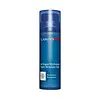What's inside
What's inside
 Key Ingredients
Key Ingredients

 Benefits
Benefits

 Concerns
Concerns

 Ingredients Side-by-side
Ingredients Side-by-side

Water
Skin ConditioningCaprylic/Capric Triglyceride
MaskingC12-15 Alkyl Benzoate
AntimicrobialGlycerin
HumectantCetearyl Alcohol
EmollientArgania Spinosa Kernel Oil
EmollientHeparan Sulfate
Skin ConditioningAcetyl Glucosamine
Skin ConditioningEthylhexyl Palmitate
EmollientGlyceryl Stearate
EmollientPEG-100 Stearate
Potassium Cetyl Phosphate
EmulsifyingCyclopentasiloxane
EmollientDimethicone
EmollientButylene Glycol
HumectantTocopheryl Acetate
AntioxidantTocopherol
AntioxidantSodium Hyaluronate
HumectantCamellia Sinensis Leaf Extract
AntimicrobialChenopodium Quinoa Seed Extract
Skin ConditioningAcrylates/C10-30 Alkyl Acrylate Crosspolymer
Emulsion StabilisingAminomethyl Propanol
Buffering1,2-Hexanediol
Skin ConditioningCaprylyl Glycol
EmollientDisodium EDTA
Water, Caprylic/Capric Triglyceride, C12-15 Alkyl Benzoate, Glycerin, Cetearyl Alcohol, Argania Spinosa Kernel Oil, Heparan Sulfate, Acetyl Glucosamine, Ethylhexyl Palmitate, Glyceryl Stearate, PEG-100 Stearate, Potassium Cetyl Phosphate, Cyclopentasiloxane, Dimethicone, Butylene Glycol, Tocopheryl Acetate, Tocopherol, Sodium Hyaluronate, Camellia Sinensis Leaf Extract, Chenopodium Quinoa Seed Extract, Acrylates/C10-30 Alkyl Acrylate Crosspolymer, Aminomethyl Propanol, 1,2-Hexanediol, Caprylyl Glycol, Disodium EDTA
Water
Skin ConditioningGlycerin
HumectantButylene Glycol
HumectantPropanediol
SolventParfum
MaskingSodium Polyacrylate Starch
AbsorbentPropylene Glycol
HumectantDimethicone
EmollientXylitylglucoside
HumectantHydroxyethyl Acrylate/Sodium Acryloyldimethyl Taurate Copolymer
Emulsion StabilisingAmmonium Acryloyldimethyltaurate/Vp Copolymer
Anhydroxylitol
HumectantEthylhexylglycerin
Skin ConditioningXylitol
HumectantDisodium EDTA
Dimethiconol
EmollientDecylene Glycol
Skin ConditioningGymnema Sylvestre Leaf Extract
AstringentGlucose
HumectantKalanchoe Pinnata Leaf Extract
MaskingZinc Gluconate
Skin ConditioningMarrubium Vulgare Extract
Skin ConditioningSempervivum Tectorum Extract
Skin ConditioningCitric Acid
BufferingHierochloe Odorata Extract
MaskingPhenethyl Alcohol
MaskingFurcellaria Lumbricalis Extract
Skin ConditioningSodium Benzoate
MaskingPotassium Sorbate
PreservativeCI 42090
Cosmetic ColorantLapsana Communis Flower/Leaf/Stem Extract
Skin ConditioningMaris Sal
Skin ConditioningWater, Glycerin, Butylene Glycol, Propanediol, Parfum, Sodium Polyacrylate Starch, Propylene Glycol, Dimethicone, Xylitylglucoside, Hydroxyethyl Acrylate/Sodium Acryloyldimethyl Taurate Copolymer, Ammonium Acryloyldimethyltaurate/Vp Copolymer, Anhydroxylitol, Ethylhexylglycerin, Xylitol, Disodium EDTA, Dimethiconol, Decylene Glycol, Gymnema Sylvestre Leaf Extract, Glucose, Kalanchoe Pinnata Leaf Extract, Zinc Gluconate, Marrubium Vulgare Extract, Sempervivum Tectorum Extract, Citric Acid, Hierochloe Odorata Extract, Phenethyl Alcohol, Furcellaria Lumbricalis Extract, Sodium Benzoate, Potassium Sorbate, CI 42090, Lapsana Communis Flower/Leaf/Stem Extract, Maris Sal
Ingredients Explained
These ingredients are found in both products.
Ingredients higher up in an ingredient list are typically present in a larger amount.
Butylene Glycol (or BG) is used within cosmetic products for a few different reasons:
Overall, Butylene Glycol is a safe and well-rounded ingredient that works well with other ingredients.
Though this ingredient works well with most skin types, some people with sensitive skin may experience a reaction such as allergic rashes, closed comedones, or itchiness.
Learn more about Butylene GlycolDimethicone is a type of synthetic silicone created from natural materials such as quartz.
What it does:
Dimethicone comes in different viscosities:
Depending on the viscosity, dimethicone has different properties.
Ingredients lists don't always show which type is used, so we recommend reaching out to the brand if you have questions about the viscosity.
This ingredient is unlikely to cause irritation because it does not get absorbed into skin. However, people with silicone allergies should be careful about using this ingredient.
Note: Dimethicone may contribute to pilling. This is because it is not oil or water soluble, so pilling may occur when layered with products. When mixed with heavy oils in a formula, the outcome is also quite greasy.
Learn more about DimethiconeDisodium EDTA plays a role in making products more stable by aiding other preservatives.
It is a chelating agent, meaning it neutralizes metal ions that may be found in a product.
Disodium EDTA is a salt of edetic acid and is found to be safe in cosmetic ingredients.
Learn more about Disodium EDTAGlycerin is already naturally found in your skin. It helps moisturize and protect your skin.
A study from 2016 found glycerin to be more effective as a humectant than AHAs and hyaluronic acid.
As a humectant, it helps the skin stay hydrated by pulling moisture to your skin. The low molecular weight of glycerin allows it to pull moisture into the deeper layers of your skin.
Hydrated skin improves your skin barrier; Your skin barrier helps protect against irritants and bacteria.
Glycerin has also been found to have antimicrobial and antiviral properties. Due to these properties, glycerin is often used in wound and burn treatments.
In cosmetics, glycerin is usually derived from plants such as soybean or palm. However, it can also be sourced from animals, such as tallow or animal fat.
This ingredient is organic, colorless, odorless, and non-toxic.
Glycerin is the name for this ingredient in American English. British English uses Glycerol/Glycerine.
Learn more about GlycerinWater. It's the most common cosmetic ingredient of all. You'll usually see it at the top of ingredient lists, meaning that it makes up the largest part of the product.
So why is it so popular? Water most often acts as a solvent - this means that it helps dissolve other ingredients into the formulation.
You'll also recognize water as that liquid we all need to stay alive. If you see this, drink a glass of water. Stay hydrated!
Learn more about Water